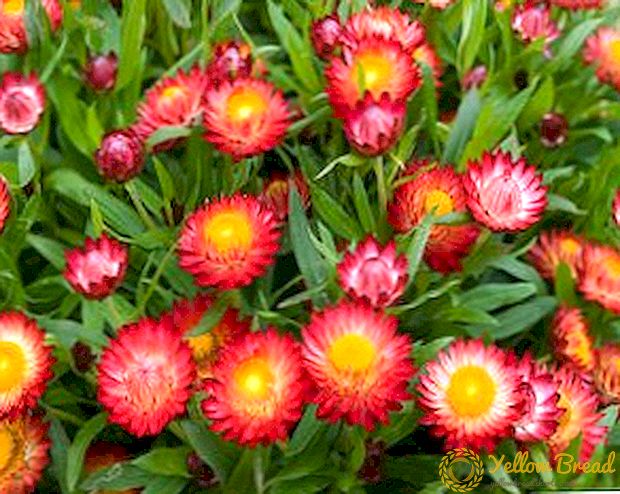 Among the many diverse berry crops that are often found on our summer cottages, some are far from being known to everyone.
Among the many diverse berry crops that are often found on our summer cottages, some are far from being known to everyone.
It is such a representative of the berry world that cloudberry is a berry with a number of useful properties.
What is it, and is it so easy to cope with its cultivation on the site - read on.
- Where grows
- Is it possible to grow cloudberries in the garden?
- How to prepare a place for landing
- Planting a plant
- How to care for healthy berries
- Soil care
- Pruning plants
- Top dressing
- Disease and pest treatment
- How to propagate cloudberries
- A little bit about the beneficial properties of berries
Where grows
If raspberries, currants, or even blackberries are more familiar to us, then it is more likely to meet cloudberries in peat bogs and in marshy wooded areas than in home breeding.
It is often found in the shrub and moss tundra of the northern and arctic forest belt in the northern hemisphere. In the conditions of the middle zone, it can often be found in the European part of the Russian Federation, Siberia, in the Far East, in Belarus. At the same time, cloudberries are cultivated in many other regions, where it creates the most comfortable conditions for growth and development.
Is it possible to grow cloudberries in the garden?
In practice, many gardeners have already confirmed the possibility of successfully growing a plant in a garden, but I must immediately say: this is a very difficult matter. Even if you know about the fastidiousness of berry bushes, then be prepared for the fact that the cloudberry in the garden will be "naughty" 10 times more than its other inhabitants.
In fact, you can’t even call it shrubs, because all the cultures we are used to have perennial above-ground shoots (lingonberries, cranberries or blueberries), while in cloudberries only the branchy underground rhizome can be classified as perennial. Despite the fact that by the end of the season and the vertical shoot slightly woody at the base, it is still one-year.
How to prepare a place for landing
As with the planting of any other plant that grows predominantly in the open nature, it is worth choosing a place for home breeding cloudberries based on the conditions in which the seedling grew, until it was dug or cut.
In this case, it is appropriate to speak of moist, fairly fertile and slightly acidic soils, always with good lighting and aeration. Also, do not forget that almost all swamp or forest dwellers have peculiar assistants represented by mycorrhiza - root fungi, very useful not only for the plant itself, but also for the soil (especially poor) on which it grows.  Therefore, planting a plant on your site, it is useful to add to the planting pit soil brought from the place of its usual growth, which will already contain microorganisms and fungi useful for cloudberries.
Therefore, planting a plant on your site, it is useful to add to the planting pit soil brought from the place of its usual growth, which will already contain microorganisms and fungi useful for cloudberries.
If you perform plant reproduction by cutting, then you can purchase mycorrhiza separately in any flower shop (by the way, they are relatively inexpensive).
You should not send cloudberries into the garden or planted along the fence. Always comply with the lighting requirements. No less useful would be information about suitable neighbors for this plant. So, in the natural environment, it feels great next to the wild rosemary, moss and lingonberries.
Planting a plant
Picking up a suitable site for cloudberries, it remains only to dig a trench (about 0.5 m deep) and build a structure for comfortable plant placement. The design consists of several layers at once: soil - polyethylene - again soil - again polyethylene. The last layer, the topmost one, should be a mixture of soil and peat or a substrate.
The prepared area must be poured abundantly with water and prepare to regularly check the level of moisture in the soil. Also no less important nuance in the successful cultivation of plants is the acidity of the soil. Ideally, this figure should be 4.5 pH.  When planting an unusual culture in the open ground, be sure to consider the required distance between the bushes. It should not be less than 20 cm.
When planting an unusual culture in the open ground, be sure to consider the required distance between the bushes. It should not be less than 20 cm.
Finally, do not forget to add a useful fungus to cloudberries. A mycorrhiza bought in a special gardening store will transport all the necessary micronutrients from water and soil to its roots.
How to care for healthy berries
Since cloudberry is a rather unusual and rare plant, few people know about its preferences in terms of growing and care. However, there is nothing supernatural here, and if you wish, you will be able to grow healthy berries without significant physical costs.
Soil care
Cloudberry's natural habitat, that is, for places where it usually grows in the wild, is characterized by high acidity of the soil. This means that when watering plants with tap water or well water there is a risk of chlorosis due to an increase in alkali in the soil.  In order to prevent this situation, ground sulfur should be added to the soil at the rate of 30 g per 1 m². You can also simply acidify the water that is used for irrigation (2 g of acetic or citric acid is enough for 1 bucket of water).
In order to prevent this situation, ground sulfur should be added to the soil at the rate of 30 g per 1 m². You can also simply acidify the water that is used for irrigation (2 g of acetic or citric acid is enough for 1 bucket of water).
Growing a swamp plant such as cloudberries, you can not ignore the level of soil moisture. It should never dry out, otherwise the plant will not bring a good harvest.
Pruning plants
The removal of shoots from cloudberry is performed exclusively for sanitary purposes, that is, for the elimination of diseased and dried branches. Most often, such pruning is carried out in early spring, before the appearance of the kidneys.
Top dressing
The described plant needs additional feeding several times per season. So, with the arrival of spring, the berries are fertilized with mineral solutions, manure and other organic compounds, and before direct fruiting (approximately at the end of spring), manure and growth biostimulants are additionally used. 
Disease and pest treatment
When growing cloudberries, you may encounter many crimson pests: raspberry mite, aphids, spider mites, strawberry raspberry weevil, stem fly and others.
Spraying with insecticides (for example, Karbofos, Aktellik, colloidal sulfur, Metafos, etc.) will help to cope with these harmful insects. To protect the plant from fungal diseases and pests with the arrival of spring, it is recommended to carry out preventive treatment with a 3% solution of Bordeaux liquids.
How to propagate cloudberries
The simplest and least costly way to get a plant bush is to transfer it to a plot from its usual habitat - if there is one near your home.
In the forest, you need to choose only specimens with large berries, not only attractive in appearance, but also tasty. Noticing such an option, the bush should be carefully dug (preferably with an earthy clod) and immediately moved to a paper bag or a pot prepared in advance.
When using a paper bag, you can plant a seedling in your garden, without getting it out of such a carrying bag. Thus, the roots of the plant do not exactly suffer, and the paper in the soil will quickly decompose. 
If you do not want to dig cloudberries with a whole bush, then for breeding in the garden you can cut the cuttings in the forest - but in this case you need to remember that this option is more troublesome.
Rooting segments (the length of the cuttings should be about 12-13 cm) should be carried out in greenhouse conditions using a nutrient substrate and plastic film, which cover the landing.
It is very important not to allow the soil to dry out in the summer, therefore, in addition to irrigation, it is important to keep the air humidity at a high level. Until the fall, such cuttings must take root, after which you will be able to transplant them to a permanent place of growth.
Although this is not at all necessary, and if there is very little time left before the onset of cold weather, it is perfectly acceptable to leave the planting material in the greenhouse until the next season. During this time, the cuttings will be even stronger and better prepared for the transplant.
Another option for breeding cloudberries on the plot - seed reproduction, which is not the best option. The fact is that plants grown from seeds may differ significantly from those from which the seeds were collected, and not always for the better.  And finally, you can just go to a specialized store or nursery and buy ready-quality varietal seedling. Many gardeners consider this the most optimal solution for planting material, but the problem isthat the majority of these seedlings are imported and may not withstand too harsh climatic conditions in the winter.
And finally, you can just go to a specialized store or nursery and buy ready-quality varietal seedling. Many gardeners consider this the most optimal solution for planting material, but the problem isthat the majority of these seedlings are imported and may not withstand too harsh climatic conditions in the winter.
A little bit about the beneficial properties of berries
The beneficial properties of cloudberries are very difficult to overestimate. Firstly, this plant is an excellent honey plant, and thanks to the components of the leaves and fruits you can cure a variety of diseases with its help. For example, the leaves are characterized by excellent hemostatic effect.
The berries of the plant include organic acids, phytosterols, tannins, fatty acids, fiber, plant sterols, antioxidants and other useful ingredients.
That is, cloudberry berries not only look great, which can be assessed by photos, but also have a wound healing, astringent, tonic, anti-feveric and antimicrobial action. In addition, regular consumption of the fruits of the shrub has anti-scorching effect. 
Some modernists use cloudberry berries in the fight against hypertension, gastrointestinal disorders and atherosclerosis, and in Siberia based on them are preparing excellent anti-cough drugs.






